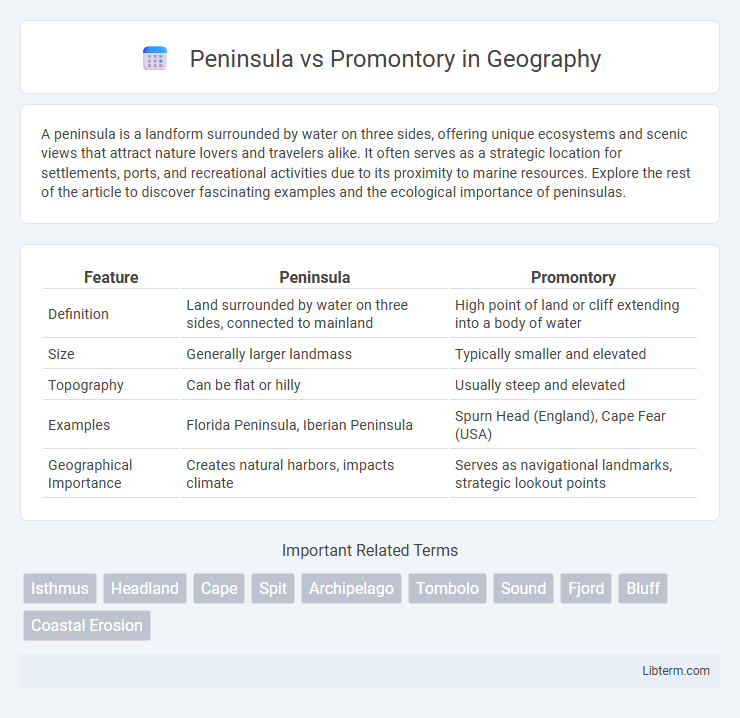A peninsula is a landform surrounded by water on three sides, offering unique ecosystems and scenic views that attract nature lovers and travelers alike. It often serves as a strategic location for settlements, ports, and recreational activities due to its proximity to marine resources. Explore the rest of the article to discover fascinating examples and the ecological importance of peninsulas.
Table of Comparison
| Feature | Peninsula | Promontory |
|---|---|---|
| Definition | Land surrounded by water on three sides, connected to mainland | High point of land or cliff extending into a body of water |
| Size | Generally larger landmass | Typically smaller and elevated |
| Topography | Can be flat or hilly | Usually steep and elevated |
| Examples | Florida Peninsula, Iberian Peninsula | Spurn Head (England), Cape Fear (USA) |
| Geographical Importance | Creates natural harbors, impacts climate | Serves as navigational landmarks, strategic lookout points |
Understanding the Basics: Peninsula vs Promontory
A peninsula is a landform surrounded by water on three sides and connected to the mainland, often larger and more habitable, supporting ecosystems and human settlements. A promontory refers to a high point of land or a cliff that juts out into a body of water, typically smaller and more abrupt, frequently used for navigation or defense. Understanding the distinction lies in size, shape, and function: peninsulas extend into water expansively, while promontories are elevated projections often marking coastal landmarks.
Key Definitions: What is a Peninsula?
A peninsula is a landform surrounded by water on three sides while remaining connected to the mainland, often extending into a sea or ocean. It differs from a promontory, which is a high point of land or cliff projecting into a water body, typically smaller and more elevated. Peninsulas vary in size from narrow strips to large landmasses like the Florida Peninsula, characterized by their unique geographic and ecological significance.
What Defines a Promontory?
A promontory is defined as a high point of land or rock that juts prominently into a body of water, often rising sharply and providing a strategic vantage point. Unlike a peninsula, which is a larger landmass surrounded by water on three sides, a promontory is typically smaller and more elevated, emphasizing its steep and prominent nature. Key characteristics of a promontory include its elevation and prominence above the surrounding terrain and water levels, making it a distinct natural landmark.
Formation Processes: How Peninsulas and Promontories Develop
Peninsulas form through the gradual accumulation of sediment or volcanic activity that extends land into bodies of water, often shaped by tectonic movements and erosion patterns. Promontories develop primarily from resistant rock formations that withstand erosion better than surrounding materials, resulting in elevated, prominent land projecting into the sea. Both landforms illustrate dynamic interactions between geological forces and environmental conditions such as wave action and sediment deposition.
Geographical Features: Differences in Shape and Size
A peninsula is a large landform surrounded by water on three sides, typically extending far into a body of water, often featuring significant length and width. In contrast, a promontory is a smaller, elevated mass of land projecting into a water body, usually characterized by steep cliffs and a more compact shape. The key geographical difference lies in the peninsula's expansive area and gradual land extension versus the promontory's limited size and prominent height.
Famous Peninsulas Around the World
Famous peninsulas around the world include the Iberian Peninsula, home to Spain and Portugal, the Arabian Peninsula, known for its vast deserts and oil reserves, and the Florida Peninsula, famous for its diverse ecosystems and tourist destinations. These landforms extend prominently into bodies of water, connecting larger land areas with surrounding seas. Unlike promontories, which are smaller and often cliff-like projections, peninsulas are larger land masses with significant cultural, historical, and ecological importance.
Iconic Promontories and Their Locations
Iconic promontories like the Rock of Gibraltar in Europe and Cape of Good Hope in South Africa are prominent landforms extending into bodies of water, offering strategic viewpoints and rich biodiversity. These elevated coastal features contrast with peninsulas, which are larger landmasses surrounded by water on three sides, such as the Florida Peninsula in the United States. Understanding the unique geological and ecological roles of promontories enhances coastal management and tourism development.
Ecological and Economic Significance
Peninsulas often support diverse ecosystems due to their extensive coastline, providing critical habitats for marine and terrestrial species while facilitating nutrient exchange that boosts local fisheries. Promontories, typically smaller and more exposed, play a vital role in coastal erosion processes and serve as important nesting sites for seabirds, contributing to biodiversity conservation. Economically, peninsulas attract tourism, fishing, and shipping industries, whereas promontories offer strategic locations for maritime navigation aids and eco-tourism focused on birdwatching and geological features.
Navigational and Historical Importance
A peninsula, extending prominently into a body of water, has historically served as a strategic naval base and key maritime trade route facilitator, exemplified by the Iberian Peninsula's role in European exploration. Promontories, often elevated headlands like Dover's White Cliffs, provide critical natural landmarks for navigation and early warning points for coastal defense. Both landforms have shaped maritime history by influencing shipping routes, territorial control, and military strategy.
Choosing the Right Term: Peninsula or Promontory?
Choosing between "peninsula" and "promontory" depends on the geographical context and scale. A peninsula is a larger landmass surrounded by water on three sides, often extending significantly into a body of water, while a promontory refers to a high, prominent point of land or rock that juts out into the sea or a lake. For detailed maps or coastal descriptions emphasizing size and landform prominence, "peninsula" suits larger features, whereas "promontory" highlights elevation and dramatic cliffs.
Peninsula Infographic

 libterm.com
libterm.com